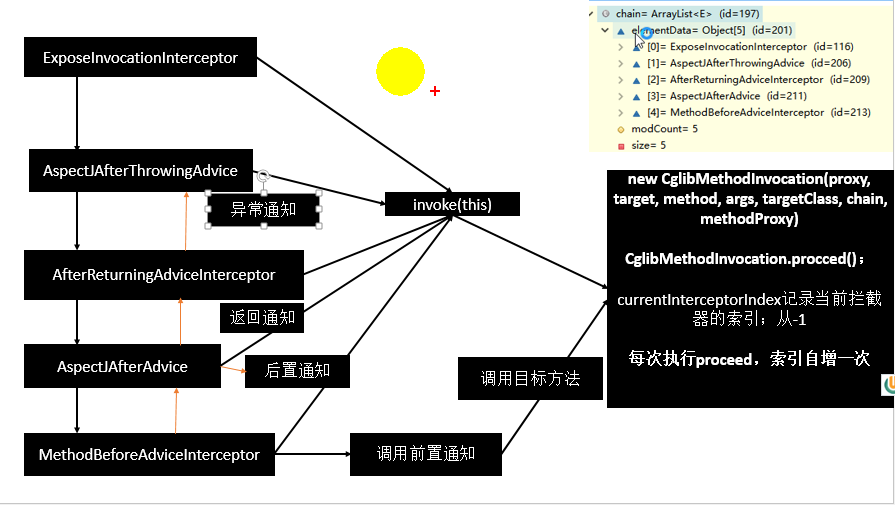spring5 源码深度解析----- AOP目标方法和增强方法的执行(100%理解AOP)
上一篇博文中我们讲了代理类的生成,这一篇主要讲解剩下的部分,当代理类调用时,目标方法和代理方法是如何执行的,我们还是接着上篇的ReflectiveMethodInvocation类Proceed方法来看
public Object proceed() throws Throwable {
// 首先,判断是不是所有的interceptor(也可以想像成advisor)都被执行完了。
// 判断的方法是看currentInterceptorIndex这个变量的值,增加到Interceptor总个数这个数值没有,
// 如果到了,就执行被代理方法(invokeJoinpoint());如果没到,就继续执行Interceptor。
if (this.currentInterceptorIndex == this.interceptorsAndDynamicMethodMatchers.size() - 1) {
return invokeJoinpoint();
}
// 如果Interceptor没有被全部执行完,就取出要执行的Interceptor,并执行。
// currentInterceptorIndex先自增
Object interceptorOrInterceptionAdvice = this.interceptorsAndDynamicMethodMatchers.get(++this.currentInterceptorIndex);
// 如果Interceptor是PointCut类型
if (interceptorOrInterceptionAdvice instanceof InterceptorAndDynamicMethodMatcher) {
InterceptorAndDynamicMethodMatcher dm = (InterceptorAndDynamicMethodMatcher) interceptorOrInterceptionAdvice;
// 如果当前方法符合Interceptor的PointCut限制,就执行Interceptor
if (dm.methodMatcher.matches(this.method, this.targetClass, this.arguments)) {
// 这里将this当变量传进去,这是非常重要的一点
return dm.interceptor.invoke(this);
}
// 如果不符合,就跳过当前Interceptor,执行下一个Interceptor
else {
return proceed();
}
}
// 如果Interceptor不是PointCut类型,就直接执行Interceptor里面的增强。
else {
return ((MethodInterceptor) interceptorOrInterceptionAdvice).invoke(this);
}
}
我们先来看一张方法调用顺序图

我们看到链中的顺序是AspectJAfterThrowingAdvice、AfterReturningAdviceInterceptor、AspectJAfterAdvice、MethodBeforeAdviceInterceptor,这些拦截器是按顺序执行的,那我们来看看第一个拦截器AspectJAfterThrowingAdvice中的invoke方法
AspectJAfterThrowingAdvice
@Override
public Object invoke(MethodInvocation mi) throws Throwable {
try {
//直接调用MethodInvocation的proceed方法
//从proceed()方法中我们知道dm.interceptor.invoke(this)传过来的参数就是ReflectiveMethodInvocation执行器本身
//这里又直接调用了ReflectiveMethodInvocation的proceed()方法
return mi.proceed();
}
catch (Throwable ex) {
if (shouldInvokeOnThrowing(ex)) {
invokeAdviceMethod(getJoinPointMatch(), null, ex);
}
throw ex;
}
}
第一个拦截器AspectJAfterThrowingAdvice的invoke方法中,直接调用mi.proceed();,从proceed()方法中我们知道dm.interceptor.invoke(this)传过来的参数就是ReflectiveMethodInvocation执行器本身,所以又会执行proceed()方法,拦截器下标currentInterceptorIndex自增,获取下一个拦截器AfterReturningAdviceInterceptor,并调用拦截器中的invoke方法,,此时第一个拦截器在invoke()方法的第七行卡住了,接下来我们看第二个拦截器的执行
AfterReturningAdviceInterceptor
@Override
public Object invoke(MethodInvocation mi) throws Throwable {
//直接调用MethodInvocation的proceed方法
Object retVal = mi.proceed();
this.advice.afterReturning(retVal, mi.getMethod(), mi.getArguments(), mi.getThis());
return retVal;
}
AfterReturningAdviceInterceptor还是直接调用mi.proceed(),又回到了ReflectiveMethodInvocation的proceed()方法中,此时AfterReturningAdviceInterceptor方法卡在第四行,接着回到ReflectiveMethodInvocation的proceed()方法中,拦截器下标currentInterceptorIndex自增,获取下一个拦截器AspectJAfterAdvice,并调用AspectJAfterAdvice中的invoke方法
AspectJAfterAdvice
@Override
public Object invoke(MethodInvocation mi) throws Throwable {
try {
//直接调用MethodInvocation的proceed方法
return mi.proceed();
}
finally {
invokeAdviceMethod(getJoinPointMatch(), null, null);
}
}
AspectJAfterAdvice还是直接调用mi.proceed(),又回到了ReflectiveMethodInvocation的proceed()方法中,此时AspectJAfterAdvice方法卡在第五行,接着回到ReflectiveMethodInvocation的proceed()方法中,拦截器下标currentInterceptorIndex自增,获取下一个拦截器MethodBeforeAdviceInterceptor,并调用MethodBeforeAdviceInterceptor中的invoke方法
MethodBeforeAdviceInterceptor
@Override
public Object invoke(MethodInvocation mi) throws Throwable {
//终于开始做事了,调用增强器的before方法,明显是通过反射的方式调用
//到这里增强方法before的业务逻辑执行
this.advice.before(mi.getMethod(), mi.getArguments(), mi.getThis());
//又调用了调用MethodInvocation的proceed方法
return mi.proceed();
}
第5行代码终于通过反射调用了切面里面的before方法,接着又调用mi.proceed(),我们知道这是最后一个拦截器了,此时this.currentInterceptorIndex == this.interceptorsAndDynamicMethodMatchers.size() - 1应该为true了,那么就会执行 return invokeJoinpoint();,也就是执行bean中的目标方法,接着我们来看看目标方法的执行
@Nullable
protected Object invokeJoinpoint() throws Throwable {
return AopUtils.invokeJoinpointUsingReflection(this.target, this.method, this.arguments);
} @Nullable
public static Object invokeJoinpointUsingReflection(@Nullable Object target, Method method, Object[] args)
throws Throwable { // Use reflection to invoke the method.
try {
ReflectionUtils.makeAccessible(method);
//直接通过反射调用目标bean中的method
return method.invoke(target, args);
}
catch (InvocationTargetException ex) {
// Invoked method threw a checked exception.
// We must rethrow it. The client won't see the interceptor.
throw ex.getTargetException();
}
catch (IllegalArgumentException ex) {
throw new AopInvocationException("AOP configuration seems to be invalid: tried calling method [" +
method + "] on target [" + target + "]", ex);
}
catch (IllegalAccessException ex) {
throw new AopInvocationException("Could not access method [" + method + "]", ex);
}
}
before方法执行完后,就通过反射的方式执行目标bean中的method,并且返回结果,接下来我们想想程序该怎么执行呢?
1 、MethodBeforeAdviceInterceptor执行完了后,开始退栈,AspectJAfterAdvice中invoke卡在第5行的代码继续往下执行, 我们看到在AspectJAfterAdvice的invoke方法中的finally中第8行有这样一句话 invokeAdviceMethod(getJoinPointMatch(), null, null);,就是通过反射调用AfterAdvice的方法,意思是切面类中的 @After方法不管怎样都会执行,因为在finally中
2、AspectJAfterAdvice中invoke方法发执行完后,也开始退栈,接着就到了AfterReturningAdviceInterceptor的invoke方法的第4行开始恢复,但是此时如果目标bean和前面增强器中出现了异常,此时AfterReturningAdviceInterceptor中第5行代码就不会执行了,直接退栈;如果没有出现异常,则执行第5行,也就是通过反射执行切面类中@AfterReturning注解的方法,然后退栈
3、AfterReturningAdviceInterceptor退栈后,就到了AspectJAfterThrowingAdvice拦截器,此拦截器中invoke方法的第7行开始恢复,我们看到在 catch (Throwable ex) { 代码中,也就是第11行 invokeAdviceMethod(getJoinPointMatch(), null, ex);,如果目标bean的method或者前面的增强方法中出现了异常,则会被这里的catch捕获,也是通过反射的方式执行@AfterThrowing注解的方法,然后退栈
总结
这个代理类调用过程,我们可以看到是一个递归的调用过程,通过ReflectiveMethodInvocation类中Proceed方法递归调用,顺序执行拦截器链中AspectJAfterThrowingAdvice、AfterReturningAdviceInterceptor、AspectJAfterAdvice、MethodBeforeAdviceInterceptor这几个拦截器,在拦截器中反射调用增强方法
spring5 源码深度解析----- AOP目标方法和增强方法的执行(100%理解AOP)的更多相关文章
- spring5 源码深度解析----- @Transactional注解的声明式事物介绍(100%理解事务)
面的几个章节已经分析了spring基于@AspectJ的源码,那么接下来我们分析一下Aop的另一个重要功能,事物管理. 事务的介绍 1.数据库事物特性 原子性多个数据库操作是不可分割的,只有所有的操作 ...
- spring5 源码深度解析----- 被面试官给虐懵了,竟然是因为我不懂@Configuration配置类及@Bean的原理
@Configuration注解提供了全新的bean创建方式.最初spring通过xml配置文件初始化bean并完成依赖注入工作.从spring3.0开始,在spring framework模块中提供 ...
- spring5 源码深度解析----- AOP代理的生成
在获取了所有对应bean的增强后,便可以进行代理的创建了.回到AbstractAutoProxyCreator的wrapIfNecessary方法中,如下所示: protected static fi ...
- spring5 源码深度解析----- AOP的使用及AOP自定义标签
我们知道在面向对象OOP编程存在一些弊端,当需要为多个不具有继承关系的对象引入同一个公共行为时,例如日志,安全检测等,我们只有在每个对象里引入公共行为,这样程序中就产生了大量的重复代码,所以有了面向对 ...
- spring5 源码深度解析----- Spring事务 是怎么通过AOP实现的?(100%理解Spring事务)
此篇文章需要有SpringAOP基础,知道AOP底层原理可以更好的理解Spring的事务处理. 自定义标签 对于Spring中事务功能的代码分析,我们首先从配置文件开始人手,在配置文件中有这样一个配置 ...
- spring5 源码深度解析----- 创建AOP代理之获取增强器
在上一篇的博文中我们讲解了通过自定义配置完成了对AnnotationAwareAspectJAutoProxyCreator类型的自动注册,那么这个类到底做了什么工作来完成AOP的操作呢?首先我们看看 ...
- spring5 源码深度解析----- 事务增强器(100%理解事务)
上一篇文章我们讲解了事务的Advisor是如何注册进Spring容器的,也讲解了Spring是如何将有配置事务的类配置上事务的,实际上也就是用了AOP那一套,也讲解了Advisor,pointcut验 ...
- spring5 源码深度解析-----ApplicationContext容器refresh过程
在之前的博文中我们一直以BeanFactory接口以及它的默认实现类XmlBeanFactory为例进行分析,但是Spring中还提供了另一个接口ApplicationContext,用于扩展Bean ...
- spring5 源码深度解析----- 事务的回滚和提交(100%理解事务)
上一篇文章讲解了获取事务,并且通过获取的connection设置只读.隔离级别等,这篇文章讲解剩下的事务的回滚和提交 回滚处理 之前已经完成了目标方法运行前的事务准备工作,而这些准备工作最大的目的无非 ...
随机推荐
- UVA 11294 wedding 2-sat
可以把一对夫妇当成一个节点,然后拆点的话,h和w分别为真和假,然后直接按照题目中说的建图染色即可 #include <iostream> #include <cstdio> # ...
- bzoj 2002 弹飞绵羊 lct裸题
上一次用分块过了, 今天换了一种lct(link-cut tree)的写法. 学lct之前要先学过splay. lct 简单的来说就是 一颗树, 然后每次起作用的都是其中的某一条链. 所以每次如果需要 ...
- 线段树模板 hdu 1166 敌兵布阵
敌兵布阵 Time Limit: 2000/1000 MS (Java/Others) Memory Limit: 65536/32768 K (Java/Others)Total Submis ...
- 深入理解 Java 中 SPI 机制
本文首发于 vivo互联网技术 微信公众号 链接:https://mp.weixin.qq.com/s/vpy5DJ-hhn0iOyp747oL5A作者:姜柱 SPI(Service Provider ...
- python实现去掉空行
# coding = utf-8def clearBlankLine(): file1 = open('text1.txt', 'r', encoding='utf-8') # 要去掉空行的文件 fi ...
- Java虚拟机原理和调优
https://blog.csdn.net/sun1021873926/article/details/78002118 115道Java经典面试题(面中率最高.最全) 史上最全 40 道 Dubbo ...
- 使用ECMAScript 6 模块封装代码
JavaScript 用"共享一切"的方法加载代码,这是该语言中最容易出错且最容易让人感到困惑的地方.其他语言使用诸如包这样的概念来定义代码作用域,但在 ECMAScript 6 ...
- 算法与数据结构基础 - 递归(Recursion)
递归基础 递归(Recursion)是常见常用的算法,是DFS.分治法.回溯.二叉树遍历等方法的基础,典型的应用递归的问题有求阶乘.汉诺塔.斐波那契数列等,可视化过程. 应用递归算法一般分三步,一是定 ...
- charles 编辑菜单总结
本文参考:charles 编辑菜单总结 charles中proxy菜单的介绍:我的是4.1.2版本,mac系统下的菜单大同小异: 如下图: 这里其实都是常用的功能: 大概可以分为5个大块,看下分割线就 ...
- 41 (OC)* OC的理解与动态特性
1:动态类型(Dynamic typing),动态绑定(Dynamic binding)和动态加载(Dynamic loading). 动态类型:即运行时再决定对象的类型.简单说就是id类型.id类型 ...
